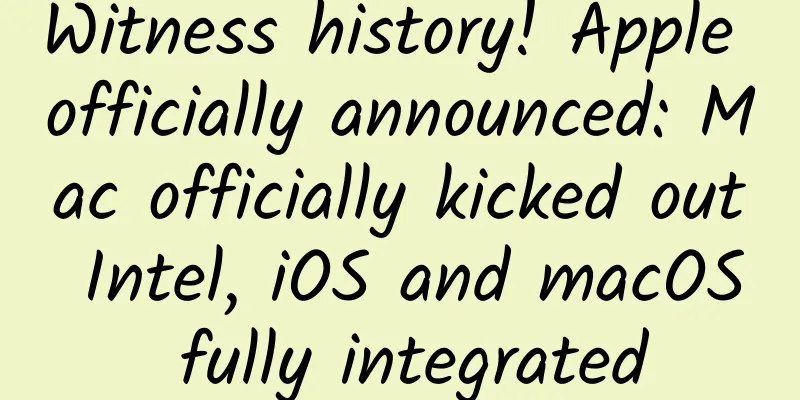Witness history! Apple officially announced: Mac officially kicked out Intel, iOS and macOS fully integrated

|
This article is reproduced from Leiphone.com. If you need to reprint it, please go to Leiphone.com official website to apply for authorization. Apple, 44 years old, has once again ushered in its historic moment. On June 22, 2020, Pacific Time, at the annual WWDC, Apple announced the heaviest and most important update to the Mac ever - migrating to Apple's own chips; at the same time, macOS and its application ecosystem also ushered in a revolutionary transformation.
At this press conference, although iOS, iPadOS and watchOS also ushered in many eye-catching updates, they all became supporting roles. Due to the impact of the epidemic, this is the first time in Apple's history that it has held WWDC online, but this does not affect its importance at all - in fact, it is the most important developer conference for Apple since it entered the Tim Cook era. This is a historic day for Apple. The biggest leap forward for the Mac everAs expected, Apple announced a historic change: Mac will migrate to Apple's own chip - Apple calls it Apple Silicon, which is actually based on the Arm architecture.
So, what does this change mean? In terms of performance and power consumption, Apple said this will make the Mac lead the industry in performance per watt and higher-performance GPUs, enabling application developers to write more powerful professional applications and high-end games. At the same time, technologies such as the neural engine based on self-developed chips will make Mac a platform for developers to use machine learning, which is of great significance to the intelligent development of Mac. It's not surprising that Apple has taken this step. After all, for more than ten years, Apple's chip design team has been building and perfecting Apple's SoC, covering multiple product lines such as iPhone, iPad and Apple Watch, and has shipped more than 2 billion chips in ten years. Mac's move toward Apple's self-developed chips is just another step for Apple to push its control over its ecosystem to the extreme. Of course, Apple made this change for major considerations in terms of operating system and application ecology. As Apple said:
Simply put, apps written by developers for iOS and iPadOS can also run on Mac. Of course, to coincide with this major change, Apple also released the latest version of macOS - macOS Big Sur, to help developers optimize and update their apps for the new processor architecture. To cooperate with developers, Apple released a series of auxiliary tools in macOS Big Sur, as follows:
In addition, to assist developers, Apple launched a new project, the Quick Start Program. The project includes some documents, format support, macOS Big Sur Beta version and Xcode 12, etc. - of course, it also includes a hardware development tool DTK (Developer Transition Kit). Leifeng.com learned that DTK is actually a computer with the appearance of Mac Mini. It has a built-in A12Z Bionic SoC, 16GB of memory, a 512GB SSD and some Mac I/O interfaces. Developers can apply online. The price of this project is $500. At the press conference, Apple also demonstrated that Apple Silicon-based Mac devices can run new versions of application software from partners such as Microsoft and Adobe, which runs very smoothly. In terms of the migration plan, Apple plans to launch the first Mac computer equipped with Apple Silicon by the end of this year and complete the transition in about two years. In the next few years, Apple will continue to support and release new versions of Intel-based macOS, and is currently developing Intel-based Macs. Apple says the transition to Apple Silicon is the biggest leap for Mac ever.
The biggest interface change since Mac OS XIn line with the migration of the entire Mac ecosystem at the processor architecture level, macOS has also ushered in a significant version - macOS Big Sur. macOS Big Sur can be said to be the biggest interface change since the birth of Mac OS X. Some key points of the interface update are as follows:
In Leifeng.com's view, through a series of updates, macOS has become more consistent with iOS and iPadOS in terms of interface style and interaction design, which fully demonstrates the integration of Apple's ecosystem. In addition to the overall interface update, Safari, the built-in browser of macOS, has also ushered in a series of updates. Apple said this is the most important update of Safari since its release in 2003. The main points are as follows:
Overall, Apple emphasizes performance and security in Safari, and strives to learn from browsers such as Chrome in terms of functionality, and its customization has also been greatly improved. In addition to Safari, apps such as Message and Maps have also been updated. Messages has added features such as pinning conversations and Memoji, while Maps has added features such as Look Around - of course, Apple has not forgotten to emphasize privacy. In other aspects, macOS Big Sur has built-in Xcode 12, which allows developers to better develop apps, and SwiftUI has been significantly updated; Mac Catalyst has also been updated with an interface, and developers have more APIs. Regarding macOS Big Sur, Apple Senior Vice President Craig Federighi said:
iOS 14 learns from Android and WeChatIn addition to Mac, the most popular thing at this WWDC is iOS 14. In the iOS 14 system, the biggest change is the home screen page, with the addition of a new App Library feature and redesigned widgets. In the App Library, apps will be automatically classified into new groups or lists. Users can not only hide app pages by themselves, but also search for apps in the top search bar. The newly designed widgets can not only display rich information content, but also support resizing and can be moved to the home screen. Users can create their own "smart overlay" widgets that automatically display related applications based on information such as time, location and activity. In addition, the new features of iOS 14 are also exciting and cannot be missed. Apple has added a new "App Clips" feature to the App Store, which is less than 10MB in size. Users can quickly experience the app functions by scanning QR codes, Apple-designed App Clips codes, or NFC sensing. In response, Apple said that this is a convenient way to explore the App Store - but it is not difficult to see that this Apple "App Clips" has the shadow of WeChat mini-programs. For video applications, Apple has added a system-wide Picture in Picture feature in iOS 14. Videos can hover over other applications and be displayed in picture-in-picture format. Users can not only resize the window, but also hide it to the side of the screen. In addition, Apple has launched a new "CarKey" feature that allows users to use their iPhone or Apple Watch as an NFC car key to unlock their car. If the device is lost, users can disable this feature through iCloud. Apple has also spared no effort in upgrading and updating existing application software. For Safari, Apple will provide users with a "privacy report" to facilitate viewing which cross-site trackers are blocked. In addition, Apple will also launch a password monitoring feature to help users detect saved passwords that may have been leaked. Not only that, the upgraded Safari will also support in-site translation; this is very practical for Chinese users. Regarding the Siri update, Apple redesigned the Siri startup interface in iOS 14. It no longer blocks the screen when waking up as before, but is displayed as an icon. In addition, Siri will also support sending audio messages, and using its neural network engine, it will also be able to support input method dictation functions. For Messages, Apple has adopted a new "pinned" method to keep the conversation interface, allowing users to pin frequently used conversations to the top of the screen for easy search. In group conversations, Apple has added precise reply functions and the "@" function to achieve targeted replies and mandatory reminders. In addition to upgrading existing applications, Apple has also brought new applications to iOS 14, such as the Translate translation software, which supports text translation and real-time voice translation, and can assist Siri's translation to work offline. iPadOS, watchOS, tvOS & HomeKitConsistent with iOS 14, iPadOS 14 also sees changes in appearance and interface, including redesigned widgets, simplified toolbars, and the addition of a sidebar function for easier management. In terms of incoming call functions and Siri interactions, iPadOS 14 adopts a new compact design, and incoming calls and Siri interactions will not appear in the form of occupying the screen. In addition, Apple has rebuilt the search function, allowing users to search in any area. Apple said that as long as you open the search box and enter a word, you can search for any information such as web pages and apps. As an important accessory of iPad, the function of Apple Pencil has also been updated at the software level. The upgraded Apple Pencil can not only recognize the user's handwriting, support English, Chinese, numbers, basic graphics, but also convert the handwriting into text. In watchOS 7, Apple also brought a number of updates, but the most important one is the sleep monitoring function. Users can personalize their sleep time, and within the set sleep time interval, the user's device will enter the "sleep aid" mode. In addition, Apple Watch will detect sleep patterns by tracking the user's breathing. In addition, it is worth mentioning that in the context of the epidemic, Apple has also added a hand-washing monitoring function to watchOS 7, using machine learning to detect hand-washing movements and a microphone to detect the sound of flowing water. The watch will automatically start counting down when washing hands. Of course, tvOS has also received some updates. For example, it can support picture-in-picture function and can also send 4K videos through the air. Regarding Apple TV+, Apple stated that this app has appeared on more than 1 billion screens and will be open to more TV brands in the future.
However, in Leifeng.com's view, the highlight of tvOS is that Apple increasingly regards it as one of the carriers of Homekit smart home. For example, when someone visits, you can be notified through HomePod, and you can also see the picture from the camera on tvOS. In addition, for HomeKit, Apple formed an alliance with Amazon, Google and other companies, and opened the HomeKit source code to allow more smart devices to be connected to the alliance - this is a new beginning for HomeKit. Leifeng.com SummaryAfter WWDC 2020, it can be said that Apple reinvented the Mac. There is no doubt that Apple's announcement at this press conference that Mac will migrate to its own chips has many similarities with Steve Jobs' announcement 15 years ago that Apple would migrate from PowerPC to Intel - but this time it is more significant. In the view of Leifeng.com, through this migration, Apple has finally taken control of the core processor architecture of all its products, and has achieved consistency and synergy among all its application ecosystems in terms of software and hardware ecosystems. The energy that will be unleashed will be enormous. It is conceivable that, driven by the iOS and iPadOS application ecosystem, the macOS application ecosystem will usher in a big explosion, and Mac sales are bound to rise accordingly. At the same time, as iOS, iPadOS, etc. are emphasizing On-Device AI and application scenarios, Mac can also benefit from On-Device AI, which is another new technological shock to the entire computer industry. Overall, at this WWDC, Apple once again demonstrated its unparalleled technical strength, product transformation capabilities, software and hardware integration advantages, and application ecosystem integration capabilities, opening up a new future for Mac and laying a solid foundation for the future of the entire Apple application ecosystem. From now on, Apple's application ecosystem will become even more competitive, and its integration and connection capabilities will be difficult for competitors in the PC and Android ecosystems to achieve.
Therefore, this cloud-based developer event fully demonstrated Apple's true strength as a technology giant of a generation. While allowing people to glimpse the future development of Apple's application ecosystem and the future development trends of the entire computer industry, it also witnessed the history of technological industry transformation. Indeed, this is the great Apple. |
>>: Big news! Kuaishou releases live streaming multi-bitrate adaptive industry standard
Recommend
Want your child to grow taller? Huaxi experts teach you how to do this...
A previous survey by the World Health Organizatio...
Lanzhou tutoring WeChat mini program function, how much does it cost to develop a tutoring appointment mini program?
With the increasingly fierce competition, more and...
Tik Tok short video operation and promotion methods!
How can companies operate and promote short video...
Where is the road to operation going?
The operations profession has only been on track ...
New bionic leg allows amputees to walk easily, it is light, powerful and can generate its own electricity
In life, everyone may encounter some misfortunes ...
Four Seasons Pharmacist says | Don’t turn “nebulization” into “misnebulization”, please avoid the “six pitfalls” of nebulization for children at home!
Winter and spring are the peak seasons for respir...
Have you crossed your legs today?
Surprise check: Are you crossing your legs at thi...
What are the Android emulator detection methods?
The general method of detecting the Android emula...
Self-taught! How sophisticated are today’s AI deception methods?
Many studies have shown that today's AI can a...
4 key points to quickly optimize the bidding OCPC delivery effect
In recent years, the competition for traffic in b...
Live streaming was a life-threatening thing in 2016, but the flavor of live streaming may change in 2017!
Specifically, the taste of the live broadcast comp...
15 essential data analysis methods for operations! !
When it comes to data analysis , people often thi...
In 2017, who will be the first to gain an oligopoly in the live streaming market?
At the beginning of 2017, the live broadcast mark...
A comprehensive inventory of model hard-working animals, dung beetles are on the list?
Today is the third day of the May Day holiday. Wh...
Which company providing SEO optimization services in Jiuquan is better? How to choose?
Nowadays, due to the increasing bidding costs, ma...









